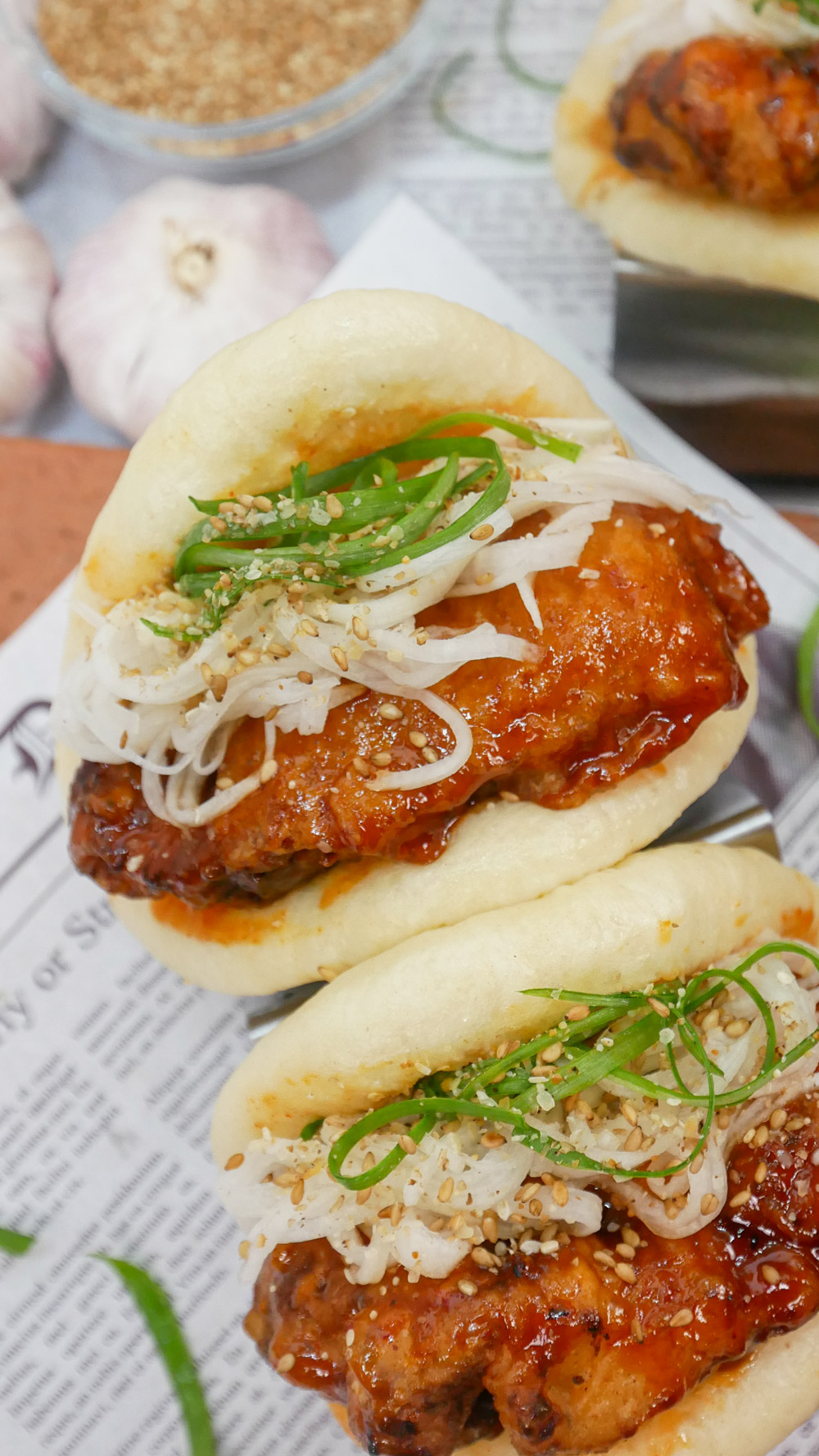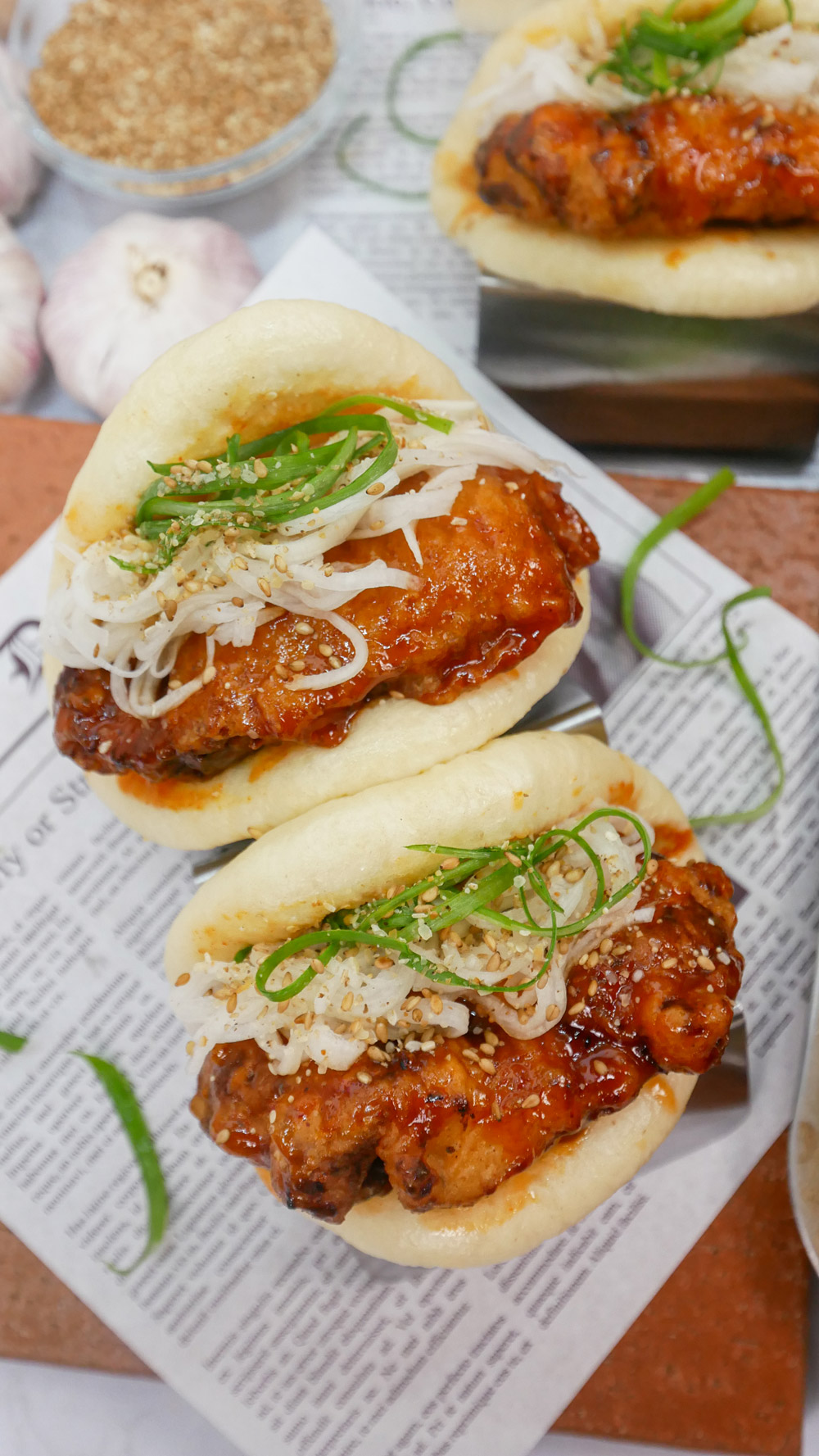If you like Korean fried chicken, wait until you try this sweet and spicy Korean fried chicken bao. The chicken is double-fried for a super crispy exterior and glazed with a delicious garlicky gochujang sauce.
For a juicy and succulent fried chicken, I like to marinate chicken thighs in milk, aromatics, salt, and pepper for at least 2 hours or overnight to help tenderize the meat.
In my opinion, Korean fried chicken isn’t complete without the pickled radish. It’s called ‘chicken mu’ in Korean, which literally translates to chicken radish. It’s sweet, tangy, a little salty, and very refreshing. Plus, you only need 5 ingredients!
This garlicky gochujang sauce will come through with most of the flavors, and to prevent the chicken from getting soggy, I recommend brushing on the sauce. You don’t want to drench the chicken!
I recommend using homemade steamed bao buns for this recipe, but if you’re pinched with time, store-bought frozen baos work too. Check out my homemade steamed bao buns recipe in the recipe card below!
Korean Fried Chicken Bao Ingredients & Substitutions
Steamed baos: steamed baos are the vessels for the fried chicken filling. I highly recommend using homemade baos but you can also use frozen versions if you don’t have time to make homemade bao buns at home.
Chicken thighs: I used boneless and skinless chicken thighs because they result in a juicy fried chicken. But you can also substitute them with chicken breasts.
Chicken Brine Ingredients & Substitutions
Whole milk: marinating the chicken thighs in whole milk helps tenderize them. You can use buttermilk as a substitute.
Ginger: ginger adds a refreshing, spicy taste to the chicken thighs. In a pinch, you can use ground ginger, but it won’t be as intense in flavor.
Garlic cloves: garlic cloves add a distinct garlicky taste and aroma that builds the flavor of the chicken. You can use garlic powder as a substitute, but the flavor won’t be as intense.
Salt: salt is used to season the chicken thighs. While I feel like the amount of salt added is the perfect ratio for me, free to adjust the amount according to your preferences.
Black pepper: black pepper adds a subtle peppery spice to the chicken thighs, enhancing its overall flavor. You can also use white pepper powder as a substitute.
Dredge & Batter Ingredients & Substitutions
All-purpose flour: all-purpose flour is the base of the dredge. You can substitute it with cornstarch.
Cornstarch: cornstarch helps create a crispy batter. I don’t recommend omitting this, as this will make the fried chicken light and crispy.
Rice flour: aside from making the coating extra crispy, rice flour prevents the coat from absorbing too much grease.
Baking powder: baking powder helps create a lighter fried chicken coating.
Garlic powder: garlic powder adds flavor and aroma of the wet batter, enhancing the overall flavors of the fried chicken. I don’t recommend using garlic cloves for this step since they can create lumps in the batter.
Onion powder: onion powder also enhances the flavor of the fried chicken, complementing the garlic powder. I also don’t recommend using real onions since they create lumps in the batter’s texture.
Cayenne pepper: cayenne pepper adds a spicy kick to the fried chicken. You can also substitute it with paprika, gochugaru, or chili powder.
Cold water: using cold water for the wet batter helps create a light and extra crispy coating on the fried chicken.
Chicken Mu (Radish) Ingredients & Substitutions
Ice cold water: using iced cold water helps keep the radishes crisp throughout the pickling process.
Korean radish: Korean radish is the main ingredient for the pickles. You can also use regular radish as a substitute.
Water: water is needed to make the pickle brine. Feel free to adjust according to the amount of pickled radish you’re making.
White vinegar: white vinegar is essential for preserving Korean radishes. As a substitute, you can use apple cider vinegar.
Sugar: sugar sweetens the pickle brine to balance out its sour and salty taste. Be sure to use white sugar or cane sugar instead of brown sugar to keep the brine clear.
Salt: salt is used to season and add flavor to the pickled radish.
Gochujang Sauce Ingredients & Substitutions
Gochujang: gochujang is the main ingredient for the sauce. It adds spicy, sweet, bold, and umami flavors to the sauce.
Soy sauce: soy sauce adds umami and seasons the sauce.
Ketchup: ketchup adds a sweet and tangy flavor to the sauce.
Rice vinegar: rice vinegar adds a sweet and acidic taste that cuts through the flavors of the sauce. As a substitute, you can use apple cider vinegar or white vinegar.
Honey: honey sweetens the sauce to balance out the savory flavors. You can use sugar as a substitute.
Sesame oil: sesame oil adds a subtle nutty and bold flavor to the sauce.
Scallions: scallions provide a pop color and freshness as garnish.
Garlic cloves: the garlic adds a delicious garlicky flavor to the sauce. Feel free to add more but not less!
How do I prepare Korean Fried Chicken Bao?
To prepare this delicious Korean Fried Chicken Bao recipe, follow the steps below!
Step 1: Cut the chicken thighs
Prepare the chicken thighs by cutting them into 2 to 3 pieces. They should be about the same size as the bao buns.
Step 2: Prepare the brine
For the brine, combine chicken with milk, garlic, ginger, salt, and black pepper. Set aside for at least 4 hours or overnight.
Step 3: Make the pickled radish
For the pickled radish, peel the skin. Then, peel the radish to create thin ribbons. Stack the ribbons, then slice them into thin strips. Combine water, sugar, white vinegar, and salt. Mix until the sugar and salt fully dissolves. Transfer the radish into a mason jar or container. Pour the brine into the jar until the radish is completely submerged. Transfer to the fridge and refrigerate for at least 2 hours.
Step 4: Make the sauce
Mix gochujang, soy sauce, ketchup, rice vinegar, honey, sugar, sesame oil, and grated garlic for the sauce. Set aside for later.
Step 5: Prepare the marinated chicken
Pat dry the chicken with a paper towel and allow it to air dry at room temperature for 30 minutes before frying.
Step 6: Prepare the dredge
For the dredge, combine cornstarch, flour, rice flour, baking powder, salt, garlic powder, onion powder, and cayenne pepper. Whisk together to combine.
Step 7: Make the wet batter
Combine 1 cup of the dredge for the wet batter with 2/3 cup cold water. Mix until just combined. The consistency should be like pancake batter.
Step 8: Preheat the oil
Heat oil over medium heat to 350°F (175°C) in a deep pan or pot.
Step 9: Coat and fry the chicken
Dip the chicken in the dredge, then into the wet batter. Allow the excess batter to drain before carefully placing it in the hot oil. Fry for 3 minutes until golden brown and crispy. Be sure to work in batches to avoid overcrowding.
Step 10: Drain excess oil
Remove and transfer to a wire rack or plate lined with paper towels. Repeat for the rest of the chicken.
Step 11: Double fry the chicken
To double-fry the chicken, increase the oil temperature to 400°F (205°C). Fry for 1 to 2 minutes until golden brown and crispy. Make sure to work in batches to avoid overcrowding.
Step 12: Coat the chicken with the sauce
Brush the sauce onto each chicken piece until they’re fully coated.
Step 13: Assemble the bao buns
To assemble the baos, layer the chicken, pickled radish, scallions, and sesame seeds.
Step 14: Plate and serve
Transfer the bao buns to a plate. Serve and enjoy!
Cooking Tips for Korean Fried Chicken Bao
Here are a few tips to keep in mind to make the most delicious Korean fried chicken bao every time!
- For the juicest full-proof fried chicken, I highly recommend using boneless skinless chicken thighs. You can you chicken breast but just be sure not to overcook them.
- Double frying is the secret to achieving that perfect crunch in Korean fried chicken. While it might seem like extra work, it’s definitely worth it!
- When frying the chicken, be sure to strain any floating batter in the oil in between batching to prevent them from burning.
- When saucing the chicken, you MUST brush the sauce on. This will ensure the fried chicken stays crispy. If you dredge the chicken or dunk it into the sauce, it will cause the chicken to get soggy and lose its crunchiness.
Frequently Asked Questions
Can I bake or air fry the chicken instead of frying?
Since the final coating on the chicken is a wet batter, it might be challenging to air fry or bake it in the oven. My guess is that the batter will fall off the chicken as it cooks however, it’s definitely an experiment worth trying!
Can I prepare the fried chicken bao in advance?
For best results, I recommend enjoying this fresh however, you can prepare the fried chicken in advance and reheat it by deep frying, air frying, or baking in the oven. Just be sure to coat the chicken in the gochujang sauce right before serving.
Can I store fried chicken bao?
Once your fried chicken bao is assembled, I don’t recommend storing it in the fridge. Since the bao buns will turn soggy from the sauce, and the fried chicken will lose its crispiness. If you do need to store the fried chicken bao, separate the bao buns and chicken and store them in airtight containers. To reheat, steam the bao bun for 10 minutes and reheat the chicken in the oven or air fryer. If the chicken is already sauced, I don’t recommend refrying it.
Looking for more easy & delicious chicken recipes?
1. Easy Chicken Katsu – captivate your taste buds with this chicken katsu recipe that’s fried to perfection. Serve it on top of fresh rice or a plate of curry for the perfect weeknight meal.
2. Air Fryer Taiwanese Popcorn Chicken – if you enjoy popcorn chicken but hate the grease, this recipe is perfect for you. It provides the crunchy and juicy elements you want from the chicken without the extra calories from deep-frying!
3. Pepsi Chicken Wings – level up your appetizer game with this finger-licking Pepsi wing recipe. Adding Pepsi to the glaze creates a sweet sticky deliciousness, that’ll have you craving for more!
4. Crispy Chicken Gizzards – these crispy chicken gizzards are the perfect accompaniment to enjoy with a cold beer or soda. The spicy garlic dipping sauce takes this to dangerously good levels!
5. Honey Butter Fried Chicken – elevate your Korean fried chicken game with this honey butter version. It is indulgent and the rich honey butter sauce pairs so deliciously with the crispy and juicy fried chicken, you’ll want this recipe on repeat!

Korean Fried Chicken Bao
Ingredients
- 8 steamed baos homemade or store-bought, see note 1
- 1 lb chicken thighs boneless & skinless
Brine
- 1/2 cup whole milk
- 1 tsp ginger minced
- 2 garlic cloves grated
- 1 tsp salt
- 1/4 tsp black pepper
Dredge
- 1/2 cup (75g) all-purpose flour
- 3/4 cup (110g) cornstarch
- 1/3 cup (40g) rice flour
- 1 tsp baking powder
- 2 tsp salt
- 1/2 tbsp garlic powder
- 1/2 tbsp onion powder
- 1/2 tsp cayenne pepper substitute with paprika or chili powder
Wet Batter
- 1 cup dredge from above
- 2/3 cup cold water
Pickled Radish (Chicken Mu)
- 2/3 cup ice cold water
- 6 oz Korean radish thinly sliced
- 3/4 cup water
- 3/4 cup white vinegar
- 3/4 cup sugar
- 3/4 tsp salt
Gochujang Sauce
- 1 tbsp gochujang Korean red chili paste
- 1 tbsp soy sauce
- 1 tbsp ketchup
- 2 tsp rice vinegar substitute with white vinegar
- 1 tbsp honey
- 1 tbsp sugar
- 1 tsp sesame oil
- 3 garlic cloves grated
Garnish
- scallions
- sesame seeds
Instructions
- Prepare the chicken thighs by cutting into 2 to 3 pieces. They should be about the same size as the bao buns.
- For the brine, combine chicken, milk, garlic, ginger, salt and black pepper. Set aside for at least 4 hours or overnight.
- For the pickled radish, peel the skin. Then, peel the radish to create thin ribbons. Stack the ribbons then slice into thin strips. Combine water, sugar, white vinegar, and salt. Mix until sugar and salt has fully dissolved. Transfer radish into a mason jar or container. Pour the brine into the jar until the radish is completely submerged. Transfer to the fridge and refrigerate for at least 2 hours.
- For the sauce, mix together gochujang, soy sauce, ketchup, rice vinegar, honey, sugar, sesame oil, and grated garlic. Set aside for later.
- Pat dry the chicken with a paper towel and allow it to air dry at room temperature for 30 minutes before frying.
- For the dredge, combine cornstarch, flour, rice flour, baking powder, salt, garlic powder, onion powder, and cayenne pepper. Whisk together to combine.
- For the wet batter, combine 1 cup of the dredge with 2/3 cup cold water. Mix until just combined. The consistency should be like pancake batter.
- In a deep pan or pot, geat oil over medium heat to 350F (175C).
- Dip the chicken in the dredge, then into the wet batter. Allow the excess batter to drain before carefully placing in the hot oil. Fry for 3 minutes. Be sure to work in batches to avoid overcrowding.
- Remove and transfer to a wire rack or plate lined with paper towels. Repeat for the rest of the chicken.
- To double fry the chicken, increase the oil temperature to 400F / 205C. Fry for 1 to 2 minutes until golden brown and crispy. Make sure to work in batches to avoid overcrowding.
- Brush the sauce onto each chicken piece until fully coated.
- To assemble the baos, layer the chicken, pickled radish, scallions, and sesame seeds.
- Serve and enjoy!
Notes
- Check out my homemade steamed bao buns recipe!
Pin & save this recipe for later!


Made these last night. I followed the recipe almost exactly. I found the rice flour I had unusable and had to omit it. I also added a little extra seasoning to dredge (though it didn’t matter cause the sauce outshines any flavor in the chicken breading). The chicken still came out nice and crispy, though I had my oil a bit too high and it made the chicken a little darker than I wanted. I think next time with rice flour and paying better attention to my oil, the breading will come out perfect. The sauce I was able to follow exactly and it so delicious. Even if I had hated the chicken, I would save this recipe just for the sauce (probably going to use it as a wing sauce next). My boyfriend and I topped our buns with sliced cucumber and regular pickled radish and it paired so well with the sauce. I definitely plan to attempt the chicken again and will continue to think of different ideas on how to use that sauce. Thanks for sharing!
Hi Christina! I’m so happy you and your boyfriend enjoyed this recipe 🙂 And yes the sauce is super addicting!! I think it’s going to be great with wings!